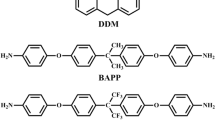Abstract
The cure behaviors, dielectric characteristics and fracture toughness of diglycidylether of bisphenol-A (DGEBA)/poly(ethylene terephthalate) (PET) blend system were investigated. The degree of conversion for the DGEBA/PET blend system was measured using Fourier transform infrared (FTIR) spectroscopy. The cure kinetics were investigated by measuring the cure activation energies (E a ) with dynamic differential scanning calorimetry (DSC). The dielectric characteristic was examined by dielectric analysis (DEA). The mechanical properties were investigated by measuring the critical stress intensity factor (K IC ), critical strain energy release rate (G IC ), and impact strength test. As a result, DGEBA/PET was successfully blended. TheE a of the blend system was increased with increasing PET content to a maximum at 10 phr PET. The dielectric constant was decreased with increasing PET content. The mechanical properties of the blend system were also superior to those of the neat DGEBA. These results were attributed to the increased cross-linking density of the blend system, resulting from the interaction between the epoxy group of DGEBA and the carboxyl group of PET.
Similar content being viewed by others
References
L. F. Thompson, C. G. Willson, and S. Tagawa,Polymers for Microelectronics: Resists and Dielectrics, ACS Symposium, Washington, DC, 1994, No. 537.
J. Seo, W. Jang, and H. Han,Macromol. Res.,15, 10 (2007).
F. L. Jin and S. J. Park,Polym. Int.,57, 577 (2008).
Y. Choe, M. Kim, and W. Kim,Macromol. Res.,11, 267 (2003).
R. S. Bauer,Epoxy Resin Chemistry, Advanced in Chemistry Series, American Chemical Society, Washington DC, 1979, No.114.
C. A. May,Epoxy resins, New York, Marcel Dekker, 1998.
S. J. Park, T. J. Kim, and H. Y. Kim,Polym. Int.,51, 386 (2002).
S. J. Park, H. Y. Lee, M. Han, and S. K. Hong,J. Colloid Interf. Sci.,270, 288 (2004).
S. M. Choi, E. K. Lee, and S. Y. Choi,Elastomer(Korea),43, 147 (2008).
J. L. Han, S. M. Tseng, J. H. Mai, and K. H. Hsieh,Angew. Makromol. Chem.,181, 193 (1990).
C. Fei and D. C. Wayne,Eur. Polym. J.,44, 1796 (2008).
J. Lee, G. R. Yandek, and T. Kyu,Polymer,46, 12511 (2005).
F. L. Jin and S. J. Park,Polym. Degrad. Stabil.,92, 509 (2007).
C. S. Zhao, F. L. Huang, W. C. Xiong, and Y. Z. Wang,Polym. Degrad. Stabil.,93, 1188 (2008).
Y. H. Shin, W. D. Lee, and S. S. Im,Macromol. Res.,15, 662 (2007).
J. Bandyopadhyay, S. S. Ray, and M. Bousmina,J. Ind. Eng. Chem.,13, 614 (2007).
S. J. Park, J. S. Jin, J. R. Lee, and P. K. Pak,Polymer(Korea),24, 245 (2000).
H. E. Kissinger,Anal. Chem.,29, 1072 (1957).
E. S. Freeman and B. Carroll,J. Phys. Chem.,62, 394 (1958).
A. R. Von Hippel,Dielectric Materials and Applications, Artech House Pub., New York, 1954.
F. P. La Mantia, R. Schifani, and D. Aciemo,J. Appl. Polym. Sci.,28, 3075 (1983).
S. J. Park, D. I. Seo, and C. W. Nah,J. Colloid Interf. Sci.,251, 225 (2002).
R. P. Smith, D. Li, D. W. Francis, J. Chappuis, and A. W. Neumann,J. Colloid Interf. Sci.,157, 478 (1993).
H. Zhang, S. Sun, M. Ren, Q. Chen, J. Song, H. Zhang, and Z. Mo,J. Appl. Polym. Sci.,109, 4082 (2008).
Author information
Authors and Affiliations
Corresponding author
Rights and permissions
About this article
Cite this article
Park, SJ. Studies on cure behaviors, dielectric characteristics and mechanical properties of DGEBA/poly(ethylene terephthalate) blends. Macromol. Res. 17, 585–590 (2009). https://doi.org/10.1007/BF03218913
Received:
Revised:
Accepted:
Issue Date:
DOI: https://doi.org/10.1007/BF03218913




